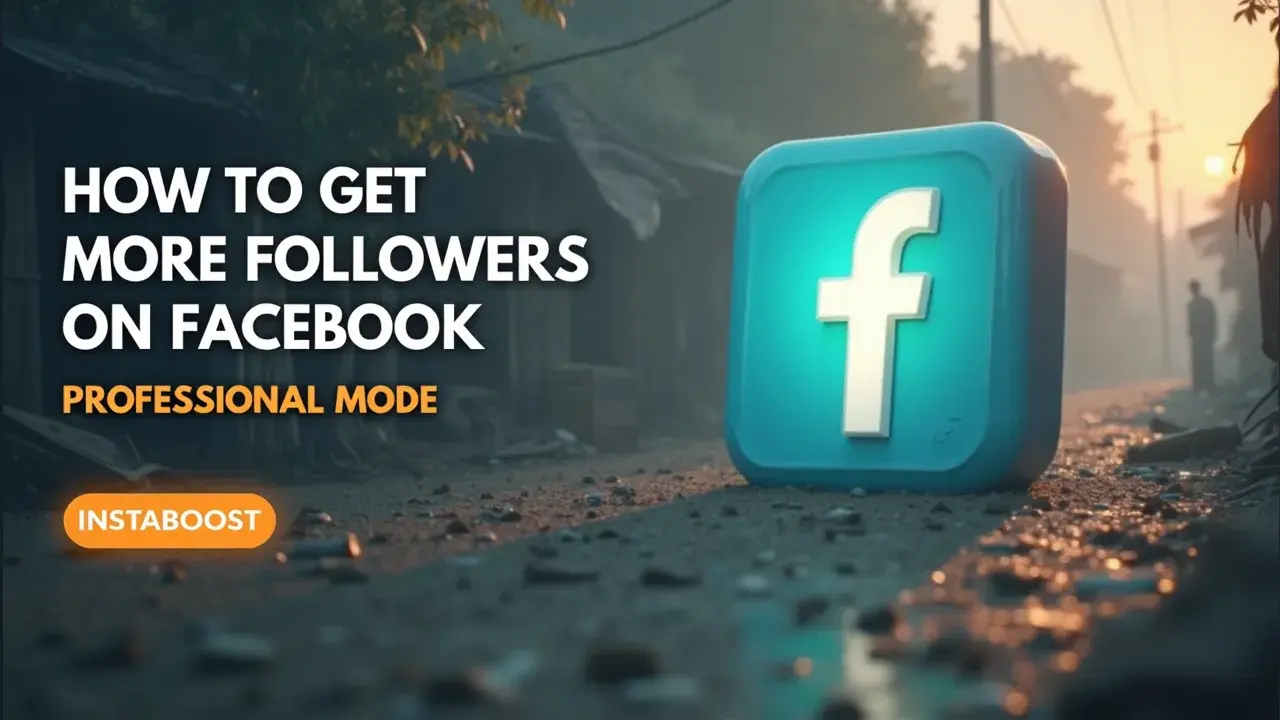How To Get More Followers on Facebook Professional Mode?
Consistent, relevant content and clear positioning help attract more followers on Facebook Professional Mode. Optimize your profile details and highlights so your niche and value are immediately clear, then publish posts that spark saves, shares, and comments to signal quality. Use built‑in insights to refine topics, timing, and formats, and maintain steady posting cadence without spammy tactics that can backfire. A focused theme and measurable iteration create sustainable growth and stronger connections.
Unlocking Facebook Professional Mode: Why Your Follower Count Matters
Before you start looking for ways to pick up more followers with Facebook’s Professional Mode, it’s useful to get clear on what actually makes this setting different. Professional Mode does more than give your profile a facelift – it turns your personal account into something closer to a public platform.
It’s really set up for people who want to build an audience, like creators or small business owners, or anyone who’s ready to reach beyond their circle of friends. When you switch it on, you have access to things like analytics, new ways to earn money, and more chances for people to see your posts.
It’s really set up for people who want to build an audience, like creators or small business owners, or anyone who’s ready to reach beyond their circle of friends. When you switch it on, you have access to things like analytics, new ways to earn money, and more chances for people to see your posts.
These tools can help, but the old shortcuts – posting a lot, sending out tons of friend requests – don’t work the same way. Facebook is paying more attention to whether you’re sharing something thoughtful, or actually responding to people, or getting real conversations going. For businesses, there are plenty of resources out there, like Facebook promotion for businesses, that can help you navigate this landscape.
So, if your goal is to grow your followers – whether you’re building a business, working on a project, or just hoping your updates reach more people – it’s important to understand what Facebook looks for now. The real value in Professional Mode comes from using its features to connect with people who actually care about what you share, not just anyone scrolling by. There are a few ways to make this easier, like making your profile simpler to find or focusing on posts that people want to talk about, and that’s what I want to get into next.

Why Trust Facebook Professional Mode?
It makes sense to have questions about Professional Mode, so it helps to look at how it actually works on Facebook. Since Facebook introduced this feature, people who switched over have usually noticed a real difference – reach goes up, and follower counts start growing, especially if they’re posting often and using the built-in analytics. The main distinction is that Professional Mode isn’t limited to your friends. Your posts can land in front of a much broader, public audience, and it’s not just a theory – Facebook’s own numbers show that creators using Professional Mode get almost twice the engagement compared to their standard profiles.
Part of this is how Facebook distributes your posts: they start appearing more often in recommendations, in search results, and in the “Suggested for You” sections that show up in people’s feeds. And if your follower count gets high enough – say, a few thousand – Facebook unlocks extra features, like more detailed audience stats and even options to earn some money. That makes it possible for your work to reach more people and to mean more for you, especially if you’re trying to build something as a creator or a small business, maybe in places where visibility is hard to come by, like Nigeria. Some people even look for ways to buy followers for Facebook group growth as a shortcut, but Professional Mode’s tools are actually designed for real, organic expansion.
If your goal is to reach more people, grow an audience, or look for ways to earn from what you do, this isn’t just a minor setting buried in your profile. The tools and reach Professional Mode offers are actually different, and regular profiles don’t really compare. The evidence backs it up, even if it sometimes feels like one more Facebook experiment among many.
Crafting Content That Sparks Action
The goal isn’t to post as much as you can, but to actually connect with people. If you want to grow your followers on Facebook’s Professional Mode, it makes a difference to think about what’s useful or interesting for the people you want to reach, instead of trying to fill up your feed. There’s a real gap between someone who scrolls past and someone who takes a second to save your post, leave a comment, or send it to someone else. That kind of response is what the algorithm notices – posts that get real engagement are more likely to show up for other people, and often reach those who will want to stick around.
It helps to slow down and consider what your ideal followers are actually looking for. Are they interested in quick tips, personal stories, or maybe a look at how you handle your work each day? You can use the analytics in Professional Mode to see what people tend to respond to; for instance, if certain posts are leading to more profile visits or shares, that’s useful to know and build on. Interestingly, some creators end up reading about things like buy post likes for Facebook pages out of curiosity, but the lasting growth really comes from building real conversation.
But it’s not all about the numbers. Making time to reply to comments, ask questions, and interact lets people see there’s a person behind the account, not just another page posting updates. Over the long run, this kind of back-and-forth leads to more than just a higher follower count – it builds a group of people who actually care about what you share. On Facebook, especially in Professional Mode, being intentional matters more than posting constantly. Sometimes one thoughtful post at the right time does a lot more for your growth than a bunch of updates that end up getting ignored.
Don’t Chase Virality – Build Substance
Going viral isn’t always all it’s made out to be. When you’re trying to pick up more followers on Facebook Professional Mode, it can seem tempting to repeat whatever’s trending, hoping that a rush of likes or shares will actually move the needle. But most viral posts come and go pretty quickly – they might get your name in front of a lot of people for a day or two, but those folks rarely stick around or take an interest in what you’ll post next.
It’s easy to forget that the algorithm looks for more than numbers; it’s built to find posts that spark real conversation or get people actually responding to each other, not just scrolling by or tapping “like.” I’ve noticed that when I share things local people care about or explain something I know well, those posts have a longer life. They draw in people who want to talk, not just those who happen to notice me on their feed one time. Somewhere along the way, I remember coming across discussions about affordable Facebook view packages, but honestly, that quick-fix approach never felt as satisfying as building engagement around what actually matters to me.
So, instead of thinking of my timeline as a dumping ground for whatever’s popular, I try to see it as a collection that says something about what I do and what matters to me. I ask myself if I’d still want someone to come across this post a few weeks from now, or if it answers a question I hear a lot, or if it’s something people won’t find anywhere else. Chasing trends always feels a bit empty after a while. I’ve found it means more to have a reputation for being steady, for sharing things that are actually useful or meaningful, even if that means growing a bit slower.
Make Space for Real Interaction
Using Facebook’s Professional Mode is less about broadcasting your opinions and more about making it easy for people to take part. It’s easy to get caught up in numbers or trying to make your profile look impressive, but what actually makes a difference is whether people feel comfortable joining the conversation. If you encourage questions, invite honest feedback, or don’t mind a bit of disagreement, you end up with a group that cares enough to stick around and actually talk. That sort of engagement doesn’t really happen because everyone always agrees, but because they know you’re listening and that what they say means something.
There are all sorts of approaches people try – some even buy reposts to grow on Facebook – but if you’re hoping to build up your followers, it’s worth thinking about your page as a place where people belong, not just a feed of your own highlights. People notice when you reply thoughtfully, ask for their perspective, or remember what they shared before. There’s not really a shortcut – real interaction stands out, and it’s what keeps a page active over time. Especially if you’re interested in earning money through your page or looking for new opportunities, the relationships you build matter a lot more than a big follower count. Letting people know you see them and that their input matters is usually what keeps them coming back, and sometimes they bring others along too, almost without thinking about it.
Stay Consistent – But Stay Curious
People always say consistency is the key if you want to build a following on Facebook Professional Mode, but I think a lot of folks skip over something important: consistency doesn’t have to mean being so predictable that it turns stale. Posting at regular times does help – people know you’re around, and the algorithm seems to care, too. Still, if each update follows the same pattern, folks start scrolling past, no matter how tidy your profile looks.
It’s not just about showing up all the time; it’s about being willing to change things up now and then. That might mean posting a quick video instead of a photo, sharing a story about how you actually make something, or answering a question that popped up in your comments. Even small tweaks, like using a Facebook emoji engagement booster to see what reactions your posts get, can shake up the routine and give you clues about what really connects. Mixing in that variety, while sticking to a steady routine, helps keep things fresh for the people who already follow you, and it can catch the attention of new folks who want something that feels both steady and interesting.
Over time, you start to notice which posts actually make people stop and respond, and you get a better sense of what draws them in – not just what’s safe, or what you’ve always done. Especially when you’re hoping to grow in a place where so many others are trying to do the same, finding that balance between being there regularly and being open to small changes seems to matter more than people think.















